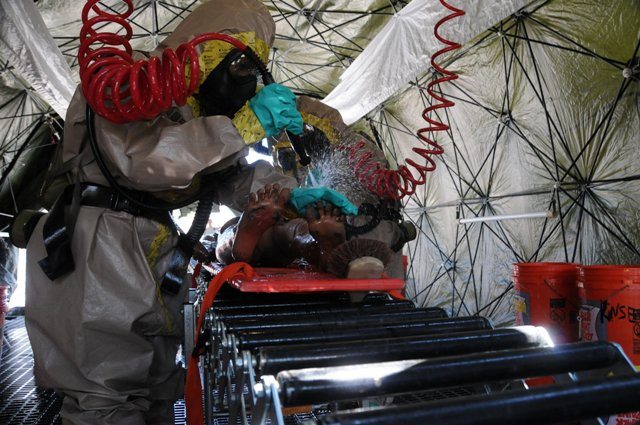Army leaders say the performance of participants in the recently concluded Vibrant Response 13 exercise has demonstrated that the U.S. military is ready to handle a major catastrophe, such as a nuclear explosion, on the homeland.
“I think what we really demonstrated was a pact that we’ve made with the American people that should something like this occur in our nation, that we have the Department of Defense capability with trained and ready response forces,” said Maj. Gen. Walter L. Davis, deputy commander, U.S. Army North.
About 9,000 service members participated in Vibrant Response from July 26 to Aug. 13. It was held on 11 training areas across 5,000 square miles in southern Indiana and northern Kentucky. The purpose of the exercise was to confirm the capabilities of various elements of the DOD’s chemical, biological, radiological, and nuclear, known as CBRN. response enterprise.
During the exercise, troops reacted to the simulated detonation of a 10-kiloton nuclear detonation in a major Midwestern city. Participants came from all four services, both the active and reserve components, and represented about 25 U.S. states and territories.
“It’s really kind of heartwarming and gratifying to see the people who are training, as an example, in search and rescue or search and recovery operations, putting on personal protective equipment and digging through rubble, and staying in it for minutes, hours, long periods of time to rescue somebody,” said Davis, who answered questions about the exercise as part of an Aug. 15 bloggers round table.
Although the exercise officially concluded, evaluation and further testing will continue through at least October.
Vibrant Response confirms the capability of the Defense CBRN Response Force as well as the Command and Control CBRN Consequence Response Elements B- team, by evaluating performance in a realistic setting. The C2CRE-B team, comprised of about 1,500 personnel, begins their mission to support the DOD’s CBRN response capability in the United States on Oct. 1. At that time, the C2CRE-A team, who also participated in Vibrant Response, will conclude their mission in that same role.
Davis said that Vibrant Response 13 served as both validation for C2CRE-B as they prepare to take on their mission, and as well as sustainment training for C2CRE-A. That type of training will continue, Davis said, in order to maintain America’s CBRNE response capability.
“We will have to continue encouraging the sustainment training,” Davis said. “These are forces that don’t have a lot training days during the year. And so we will really have to continue to emphasize, maximizing as we go through the course of next year, the collective training for those units as they return back to their installations.”
Preparations have already begun for next year’s Vibrant Response exercise, and Davis said lessons learned from this year’s exercise, and from those in past years, will be applied to the next exercise.
“We’ve learned a lot of lessons over three or four years of conducting this,” he said. “And so each time we try to improve it in terms of what we need to do to improve the entire enterprise and its preparedness to respond.”










